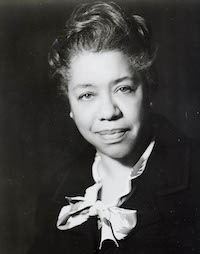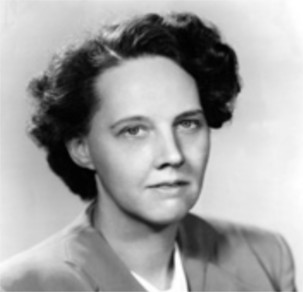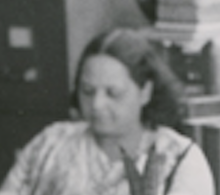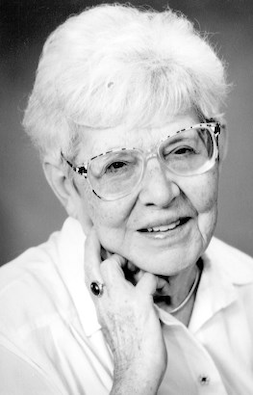
Ruth Sawyer was an American storyteller and a writer of fiction and non-fiction for children and adults. She may be best known as the author of Roller Skates, which won the 1937 Newbery Medal. She received the Laura Ingalls Wilder Award in 1965 for her lifetime achievement in children's literature.

The Schomburg Center for Research in Black Culture is a research library of the New York Public Library (NYPL) and an archive repository for information on people of African descent worldwide. Located at 515 Malcolm X Boulevard between West 135th and 136th Streets in the Harlem neighborhood of Manhattan, New York City, it has, almost from its inception, been an integral part of the Harlem community. It is named for Afro-Puerto Rican scholar Arturo Alfonso Schomburg.

Augusta Braxton Baker was an American librarian and storyteller. She was known for her contributions to children's literature, especially regarding the portrayal of Black Americans in works for children.
Alice Rose Provensen and Martin Provensen were an American couple who illustrated more than 40 children's books together, 19 of which they also wrote and edited. According to Alice, "we were a true collaboration. Martin and I really were one artist."

Anne Carroll Moore was an American educator, writer and advocate for children's libraries.

Lawrence Clark Powell was an American librarian, literary critic, bibliographer and author of more than 100 books. Powell "made a significant contribution to the literature of the library profession, but he also writes for the book-minded public. His interests are reflected in the subjects that recur throughout his writings; these are history and travel, especially concerning the American Southwest, rare books, libraries and librarianship, the book trade, and book collecting."
May Massee was an American children's book editor. She was the founding head of the juvenile departments at Doubleday from 1922 and at Viking Press from 1932. Before working at Doubleday, she edited the American Library Association periodical Booklist.
Peggy Sullivan was an American librarian and educator. She was elected president of the American Library Association and was a scholar of the history of librarianship.

Frances E. Henne was an American librarian. Henne pursued a life of education and became a leader and expert in creating standards for school librarians. In 1999, American Libraries named her one of the "100 Most Important Leaders We Had in the 20th Century."

Adelaide Rosalie Hasse is listed as one of the "100 most important leaders we had in the 20th century" in the December 1999 edition of American Libraries. She is credited with having developed the Superintendent of Documents Classification system used by the Government Printing Office and Federal Depository Library Program.

Margaret Clara Scoggin was one of the first librarians to expand dramatically upon the idea of young adult public librarianship. Scoggin implemented several programs throughout her career at the New York Public Library that placed intense importance on young adult readers, which ultimately inspired the ever-improving teen librarianship seen today. She said of young adults, "They are a vital force which the library can both develop and use. They are the voters of tomorrow, the potential adult users and supporters of the public library, the emergent community to whom, theoretically, the public library belongs." In 1999, American Libraries named her one of the "100 Most Important Leaders We Had in the 20th Century".

Frances Lander Spain was a children's librarian and an instructor of school library services. In 1960, she became the first children's librarian to ever hold the position of president of the American Library Association (ALA). Spain was named one of the library's "100 Most Important Leaders We Had in the 20th Century."

Doris Gates was one of America's first writers of realistic children's fiction. Her novel Blue Willow, about the experiences of Janey Larkin, the ten-year-old daughter of a migrant farm worker in 1930s California, is a Newbery Honor book and Lewis Carroll Shelf Award winner. A librarian in Fresno, California, Gates lived and worked among the people described in her novels. She is also known for her collections of Greek mythology.
Frances Jenkins Olcott was the first head librarian of the children's department of the Carnegie Library of Pittsburgh in 1898. She also wrote many children's books and books for those in the profession of providing library service to children and youth.
Romana Javitz was an American artist, librarian, and Superintendent of the Picture Collection at the New York Public Library.

Catherine Allen Latimer was the New York Public Library's first African-American librarian. She was a notable authority on bibliographies of African-American life and instrumental in forming the library's Division of Negro History, Literature and Prints.

Frances Burns Linn was an American librarian, the head librarian of the Santa Barbara Library from 1906 to 1943. She was inducted into the California Library Hall of Fame in 2018.

Elizabeth Nesbitt, also known as Betty Nesbitt was an American children's librarian and a library science educator. She was known “internationally as an authority on children's literature”, and made “(s)trong contributions” to children's librarianship.

Sheila Agnes Egoff was a Canadian librarian, literary critic, and historian who was Canada's first professor of children's literature. A recipient of the Order of Canada, she was known for her studies of children's fiction including The Republic of Childhood (1967), Thursday's Child (1981) and Worlds Within (1988). The Sheila A. Egoff Children's Literature Prize is named after her.














